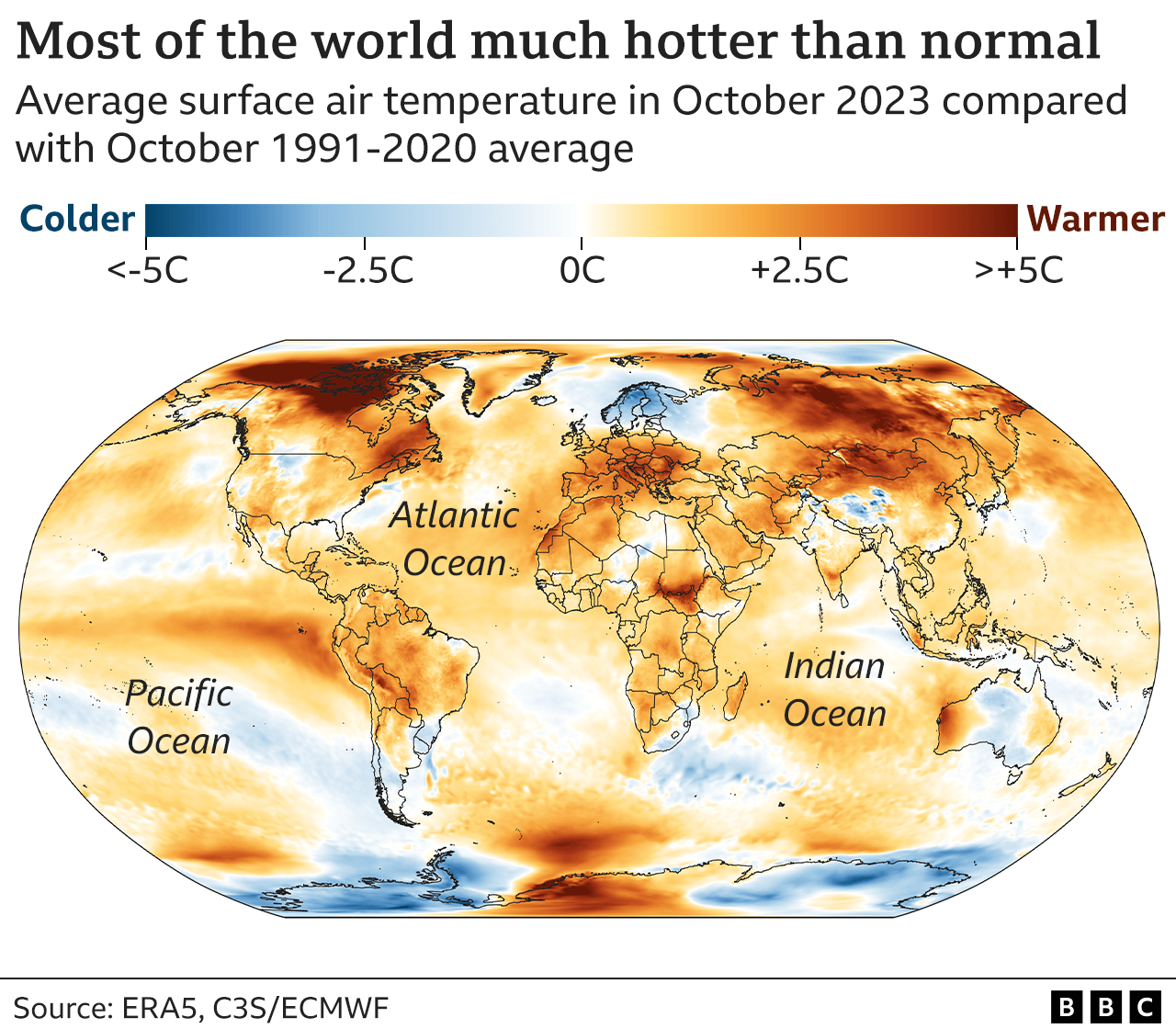Global heat: Extreme autumn sets up 2023 to break records
- Published
- comments

A woman drinks water in Istanbul as it bakes in 40C heat in July of this year
It is now "virtually certain" that 2023 - a year of deadly heatwaves, floods and fires - will be the warmest on record, new data suggests.
The prediction follows "exceptional" high October temperatures.
Global average air temperatures were 0.4C warmer than the previous high of October 2019, according to the EU's climate change service.
Driven by carbon emissions and an El Niño weather event, this was the fifth month in a row of record warmth.
Extreme global temperatures will likely continue into 2024, researchers say.
That this year will be the warmest ever recorded is now pretty much unavoidable: the last two months of 2023 are extremely unlikely to reverse the trend and high temperatures around the world have continued into November.
October's temperature mark adds to this year's list of tumbling global heat records.
The number of days breaking through the politically significant 1.5C warming threshold has already reached a new high, well before the end of the year.
July was so warm that it may have been the hottest month in 120,000 years, while average September temperatures smashed the previous record by a "gobsmacking" 0.5C.
October was not quite as unusually hot as September but still breaks the record for the month by an "exceptional" margin, according to the Copernicus Climate Change Service.
The month was 1.7C warmer than the pre-industrial average - meaning compared with the period before humans started burning large amounts of fossil fuels.

The warmth experienced throughout the year so far means that 2023 is "virtually certain" to become the world's warmest year on record, beating 2016.
That's the view of a number of science bodies, including Copernicus and US groups NOAA and Berkeley Earth.
"We really see no sign that this year's string of exceptional record-setting months is going away anytime soon," said Zeke Hausfather, a climate scientist at Berkeley Earth.
"And at this point, it makes it virtually certain in all the datasets that 2023 will be the warmest year on record. That's a greater than 99% chance," he told BBC News.
'Record human suffering'
While many researchers are concerned about the scientific impacts of record-breaking temperatures this year, others point to the fact that the rising mercury has real world consequences.
"The fact that we're seeing this record hot year means record human suffering," said Dr Friederike Otto from Imperial College London, commenting on the findings.
"Within this year, extreme heatwaves and droughts made much worse by these extreme temperatures have caused thousands of deaths, people losing their livelihoods, being displaced etc. These are the records that matter."
The main driver of the heat is ongoing emissions of carbon dioxide, mainly from burning fossil fuels. It is being supplemented this year by the rise of El Niño - a natural event where warm waters come to the surface in the east Pacific Ocean and release extra heat into the atmosphere.
El Niño conditions have gained strength over recent months, but have not yet reached their peak.
"This El Niño is weird. Part of the heat we're experiencing is not just due to the increase in El Niño, it's due to this rapid switch out of (ocean-cooling weather event) La Niña conditions as well, that has been suppressing temperatures for the last few years," said Dr Hausfather.
Scientists are uncertain as to whether this Niño event is different from others in recent decades. Some are concerned that it might be driving greater heating at the ocean surface than during previous events such as the ones in 1997 and 2015. The jury is still out on that.
The year to date has been a record 1.43C warmer than the pre-industrial levels according to Copernicus, with temperatures expected to remain high in the coming months.

Samantha Burgess, Deputy Director of the Copernicus Climate Change Service, said that a combination of its data and that of the UN suggested 2023 may be "warmer than anything that the planet has seen for 125,000 years".
That conclusion is based on observations at weather stations, complex computer models of the climate system, and records of the climate far back in time from ice cores and tree rings, for example.
It sets the worrying climate context ahead of the UN's COP28 summit, which begins on 30 November.
"The sense of urgency for ambitious climate action going into COP28 has never been higher," said Dr Burgess.

Impacts of rising temperatures seen across the world
October temperatures were much higher than average globally, and different parts of the world faced extreme conditions.
In the UK, temperatures were around 1C above average, with southern England warmest at 1.7C above normal. Wet conditions also persisted and saw average precipitation around 40% above average.
In Italy, October temperatures were over 3C higher than normal, also coinciding with significant flooding in some parts of the country.
A drought related to El Niño saw the driest October on the Panama canal since 1950. Parched conditions continue to impact the operations of this important trade route heading into the drier time of the year.
Parts of the Middle East have also been hit by drought, while East Africa has been hit by deadly floods.

High temperatures around the world have continued into November with hundreds of heat records already broken this month in Japan.
Europe meanwhile saw temperatures over 35C for the first time ever in November, with high readings in several parts of Greece.
As these temperatures surge, there are concerns that further extreme events may follow in the coming months.
For example, parts of Australia have already been warned of an "increased risk" of wildfires.